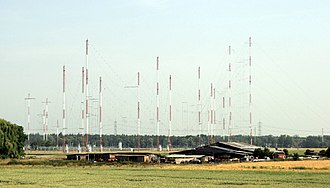

Curtain arrays are a class of large multielement directional radio transmitting wire antennas, used in the short-wave radio bands.[1] They constitute a type of reflective array antenna, consisting of multiple wire dipole antennas, suspended in a vertical plane, often positioned in front of a "curtain" reflector made of a flat vertical screen of many long parallel wires.[1] These are suspended by support wires strung between pairs of tall steel towers, reaching heights of up to 90 m (300 feet) high.[1] Primarily employed for long-distance skywave (or skip) transmission, they emit a beam of radio waves at a shallow angle into the sky just above the horizon, which is then reflected by the ionosphere back to Earth beyond the horizon. Curtain arrays are extensively used by international short-wave radio stations for broadcasting to large areas at transcontinental distances.[1]
Due to their powerful directional characteristics, curtain arrays are frequently utilized by government propaganda radio stations to beam propaganda broadcasts across national borders into other nations. For instance, curtain arrays were used by Radio Free Europe and Radio Liberty to broadcast into Eastern Europe.
- ^ a b c d Griffith, B. Whitfield (2000). Radio-electronic Transmission Fundamentals, 2nd Ed. SciTech Publishing. p. 477. ISBN 1884932134.